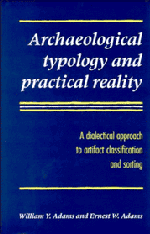 Archaeological Typology and Practical Reality
Archaeological Typology and Practical Reality Book contents
- Frontmatter
- Contents
- List of figures
- List of tables
- The archaeologist's preface
- The philosopher's preface
- PART I Introductory
- PART II The nature of types and typologies
- PART III Typology in action: the Medieval Nubian Pottery Typology
- PART IV Pragmatics of archaeological typology
- PART V Classification, explanation, and theory
- 22 The Typological Debate
- 23 Issues and non-issues in the Typological Debate
- 24 Conceptual problems
- 25 The use and abuse of theory
- 26 Paradigms and progress
- Appendices
- References
- Index
25 - The use and abuse of theory
Published online by Cambridge University Press: 23 November 2009
- Frontmatter
- Contents
- List of figures
- List of tables
- The archaeologist's preface
- The philosopher's preface
- PART I Introductory
- PART II The nature of types and typologies
- PART III Typology in action: the Medieval Nubian Pottery Typology
- PART IV Pragmatics of archaeological typology
- PART V Classification, explanation, and theory
- 22 The Typological Debate
- 23 Issues and non-issues in the Typological Debate
- 24 Conceptual problems
- 25 The use and abuse of theory
- 26 Paradigms and progress
- Appendices
- References
- Index
Summary
One of the most insightful early discussions of archaeological typology and its problems was “The use and abuse of taxonomy,” by J. O. Brew (1946: 44–66). (In most contexts “taxonomy” was to Brew what “typology” is to us.) Brew was not the first to recognize the theoretical problems involved in archaeological classification (cf. Kluckhohn 1939: 338; Rouse 1939: 9–35), but he was one of the first who correctly understood their nature. It was not (as Kluckhohn had implied) that artifact types had no theoretical significance, but that their significance was widely misinterpreted. Brew saw this as evidence that typological practice was being used in ways inappropriate to theory-building – hence the title of his chapter. Here we will argue, conversely, that theory has often been used in ways inappropriate to typology-building.
We have suggested at many points in this book that there really was not, and is not, anything seriously wrong with the practice of artifact classification. By the time that Brew wrote, however, it had largely achieved its original goal of erecting a basic time/space grid for the contextualization of North American archaeological materials. Precisely because this edifice was now largely complete, archaeologists were beginning to look around for new questions to ask. As they did so, they began to criticize the old typologies because they were not answering the new questions. As we will see a little later, this is one of the frequent consequences of paradigm shifts in the social sciences.
- Type
- Chapter
- Information
- Archaeological Typology and Practical RealityA Dialectical Approach to Artifact Classification and Sorting, pp. 305 - 313Publisher: Cambridge University PressPrint publication year: 1991


